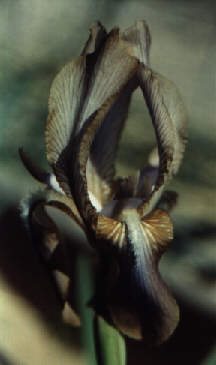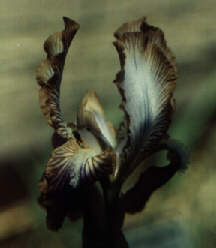Stoloniferabreds
|
I. stolonifera (Maxim, 1880) An extremely vigorous species, which spreads by stolons so under favorable conditions it can travel further and faster than the most aggressive TB. This open pattern of growth makes it relatively rot-resistant, but also presents a challenge in keeping selected clones correctly labeled. The flowers are highly variable with ground colors ranging from white through cream and yellow to blue. Some variants are brownish at the edges, blending to blue in the center. Some are intricately veined. Many distinct variants have been noted and a number of selected clones have been registered. These four illustrate some of that variability. |
|||||||||||
|
|
|
|
|
||||||||
|
Bluish |
Brownish |
Yellow |
Persian Cupid |
||||||||
This is a tetraploid species that has proven at least partially compatible with other tetraploids, with intricate patterns and color combinations rarely found in a single species. One of my early experimental lines involved collecting as many different I. stolonifera variants as I could and crossing them with modern TBs to get first-generation halbreds. The plan was then to linebreed these stoloniferabreds, treating them as a separate, fertile family that could not only be maintained but also used with other compatible families. At the time, I was working with Col. Gus Seligmann, who had an impressive collection of TBs in his shaded valley garden. I discontinued the program after his death, because my own garden simply couldn't support the needed TB population. If I'd had the resources, I would certainly have continued work with this line.
Over the years, I. stolonifera has been used to produce a number of registered arilbreds with no other aril ancestry. Here is the list I compiled from the 1976 Checklist, used in planning my program, and maintained in hopes of resuming work with it. Most of these are older and many have dwarf ancestry. Some, however, are fully fertile halfbreds and would be useful in such a program even today.
|
1/2-bred |
DUST STORM (Kenneth Kidd, 1953). (Jean Cayeau x Summer Tan) X I. stolonifera. Dust brown self. Rainbow, 1953. |
|||
|
1/2-bred |
LITTLE MASTER (Sass Brothers, R. 1946). I. stolonifera X DB. AIS Color Class: S9D (dark reddish bitone squalens). |
|||
|
3/4-bred |
MOMENTS LATER (Elm Jensen, 1989). I. stolonifera X Stolpum Seedling #1: (I. stolonifera x yellow pumila). S medium beige brown, blue center, electric violet flush on midrib; F same flushed violet and rose, white haft veining; orange beard tipped lavender; slight sweet fragrance. |
|||
|
1/2-bred |
MOUNTAIN POTTERY (Sass Brothers, R. 1946). I. stolonifera X dwarf bearded. AIS Color Class: S9D (dark reddish bitone squalens). |
|||
|
1/2-bred |
NEW ERA (Sass Brothers, 1949). I. stolonifera X dwarf bearded. AIS Color Class: S6D (dark yellow squalens bitone). |
|||
|
1/2-bred |
SAFFRON CHARM (D. E. Benbow, 1954). I. stolonifera X TB seedling. Blend of saffron grey and lavender. |
|||
|
1/2-bred |
SILKEN DALLIANCE (H. Senior Fothergill, 1958). I. stolonifera X Bright Melody. Violet-blue self edged sienna-brown. |
|||
|
1/2-bred |
SPRING CAPER (Sass Brothers, 1949). I. stolonifera X Dwarf Bearded. AIS Color Class: S6D (dark yellow squalens bitone). |
|||
|
1/2-bred |
STOL-BEE (Emma Hobbs, 1974). I. stolonifera X unknown. S greyed gold; F greenish gold with red-violet ray pattern, gold beard tipped violet. |
|||
|
3/4-bred |
STOLEN MOMENTS (Elm Jensen, 1989). I. stolonifera X Stol-pum seedling. S bright yellow, midrib-flushed green. F bright yellow, hafts veined white, blue flush below beard. Orange beard tipped lavender. |
|||
|
1/2-bred |
TWILIGHT (William R. Dykes, 1923-24). I. germanica X I. stolonifera. AIS Color Class: S3L (light blue squalens bitone). |
|||



